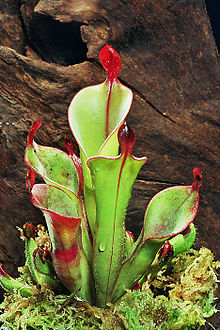
Pitcher plants are several different carnivorous plants that have modified leaves known as pitfall traps—a prey-trapping mechanism featuring a deep cavity filled with digestive liquid. The traps of what are considered to be "true" pitcher plants are formed by specialized leaves. The plants attract and drown their prey with nectar.
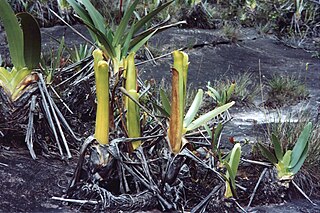
Brocchinia reducta is a carnivorous plant in the bromeliad family. It is native to southern Venezuela, Brazil, Colombia, and Guyana, and is found in areas with nutrient-poor, high moisture soil. B. reducta is able to grow in sparse conditions, which is evident when it uses its roots as anchors over rocks. Its funnel-like structure and waxy coating, among other characteristics, suggest that this plant is carnivorous.
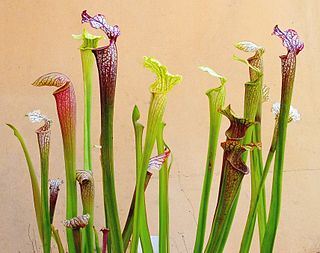
Sarracenia is a genus comprising 8 to 11 species of North American pitcher plants, commonly called trumpet pitchers. The genus belongs to the family Sarraceniaceae, which also contain the closely allied genera Darlingtonia and Heliamphora.
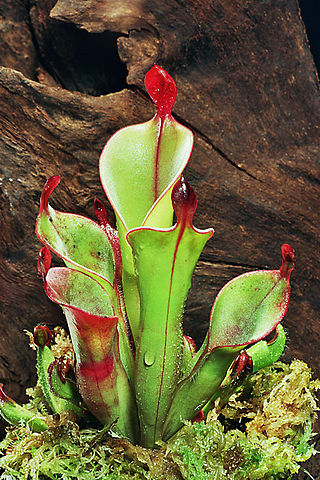
The genus Heliamphora contains 24 species of pitcher plants endemic to South America. The species are collectively known as sun pitchers, based on the mistaken notion that the heli of Heliamphora is from the Greek helios, meaning "sun". The name instead derives from the Greek helos, meaning "marsh", so a more accurate translation of their scientific name would be marsh pitcher plants. Species in the genus Heliamphora are carnivorous plants that consist of a modified leaf form that is fused into a tubular shape. They have evolved mechanisms to attract, trap, and kill insects; and control the amount of water in the pitcher. At least one species produces its own proteolytic enzymes that allows it to digest its prey without the help of symbiotic bacteria.

Cephalotus is a genus which contains one species, Cephalotus follicularis the Albany pitcher plant, a small carnivorous pitcher plant. The pit-fall traps of the modified leaves have inspired the common names for this plant, which include 'Albany pitcher plant", "Western Australian pitcher plant", "Australian pitcher plant", or "fly-catcher plant." It is an evergreen herb that is endemic to peaty swamps in the southwestern corner of Western Australia.

Darlingtonia californica, also called the California pitcher plant, cobra lily, or cobra plant, is a species of carnivorous plant. It is the sole member of the genus Darlingtonia in the family Sarraceniaceae. This pitcher plant is native to Northern California and Oregon, US, growing in bogs and seeps with cold running water usually on serpentine soils. This plant is designated as uncommon due to its rarity in the field.
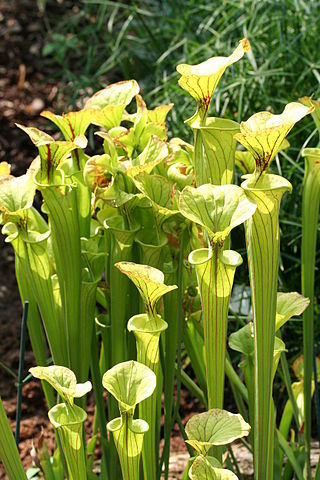
Sarracenia flava, the yellow pitcherplant, is a carnivorous plant in the family Sarraceniaceae. Like all the Sarraceniaceae, it is native to the New World. Its range extends from southern Alabama, through Florida and Georgia, to the coastal plains of southern Virginia, North Carolina and South Carolina. Populations also exist in the Piedmont, Mendocino County, California and mountains of North Carolina.

Sarracenia purpurea, the purple pitcher plant, northern pitcher plant, turtle socks, or side-saddle flower, is a carnivorous plant in the family Sarraceniaceae.

Heliamphora minor is a species of marsh pitcher plant endemic to Auyán-tepui in Venezuela. As the name suggests, it is one of the smallest species in the genus. It is closely related to H. ciliata and H. pulchella.
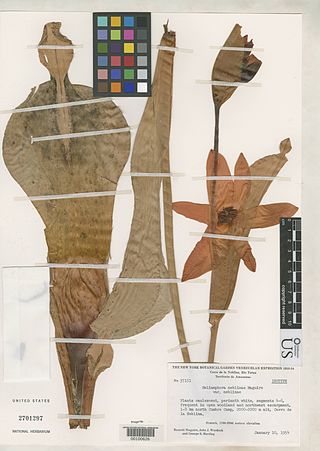
Heliamphora neblinae is a species of marsh pitcher plant endemic to Cerro de la Neblina, Cerro Aracamuni and Cerro Avispa in Venezuela. It is one of the most variable species in the genus and was once considered to be a variety of H. tatei. It is unclear whether or not there is a consensus regarding its status as a species, with at least a few researchers supporting the taxonomic revision that would elevate both H. tatei var. neblinae and H. tatei f. macdonaldae to full species status.

Heliamphora nutans is a species of marsh pitcher plant native to the border area between Venezuela, Brazil and Guyana, where it grows on several tepuis, including Roraima, Kukenán, Yuruaní, Maringma, and Wei Assipu. Heliamphora nutans was the first Heliamphora to be described and is the best known species.
Heliamphora sarracenioides is a species of marsh pitcher plant endemic to Ptari Tepui in Bolívar state, Venezuela. Approximately 200 mature plants were observed in the type locality, however this site's true location and information regarding sympatric species has not been disclosed for conservation reasons. The species differentiates itself from others by the extremely wide pitcher lid, which resembles Sarracenia species. It is closest to H. heterodoxa and H. folliculata, from which it can be distinguished by the large lid glands and width of the pitcher lid.

Heliamphora tatei is a species of marsh pitcher plant endemic to Cerro Duida, Cerro Huachamacari and Cerro Marahuaca in Venezuela. It is closely related to H. macdonaldae, H. neblinae, and H. parva, and all three have in the past been considered forms or varieties of H. tatei. Like H. tatei, these species are noted for their stem-forming growth habit.

Archaeamphora longicervia is a fossil plant species, the only member of the hypothetical genus Archaeamphora. Fossil material assigned to this taxon originates from the Yixian Formation of northeastern China, dated to the Early Cretaceous.
Palaeoaldrovanda splendens is a form taxon of uncertain identity.

A protocarnivorous plant, according to some definitions, traps and kills insects or other animals but lacks the ability to either directly digest or absorb nutrients from its prey like a carnivorous plant. The morphological adaptations such as sticky trichomes or pitfall traps of protocarnivorous plants parallel the trap structures of confirmed carnivorous plants.

Carnivorous plants are plants that derive some or most of their nutrients from trapping and consuming animals or protozoans, typically insects and other arthropods, and occasionally small mammals and birds. They still generate all of their energy from photosynthesis. They have adapted to grow in waterlogged sunny places where the soil is thin or poor in nutrients, especially nitrogen, such as acidic bogs. They can be found on all continents except Antarctica, as well as many Pacific islands. In 1875, Charles Darwin published Insectivorous Plants, the first treatise to recognize the significance of carnivory in plants, describing years of painstaking research.
Heliamphora uncinata is a species of Marsh Pitcher Plant endemic to Venezuela. This species of carnivorous plant is known as a pitcher plant. Individuals use tube like leaves to trap insects that slip into the bottom. At the bottom of the "pitcher" there are digestive juices which slowly digest the prey item to give the plant additional nutrients. The pitchers of this species are around 25–35 cm long, and are 8–10 cm wide at the opening. The pitcher mouth is circular in shape and the back is raised to form the lid. It is known only from the type collection, which was made in a narrow canyon on Amurí-tepui. There it grows at an elevation of approximately 1850 m on sandstone cliff faces in shady conditions. It is also found in humus pockets and cracks at this location. The only other species in the genus known to have a similar growth habit is H. exappendiculata. These two taxa also share a number of morphological features and appear to be closely related. These shared morphological features include: the shape of pitchers, the general growth pattern, and appearance of nectaries.
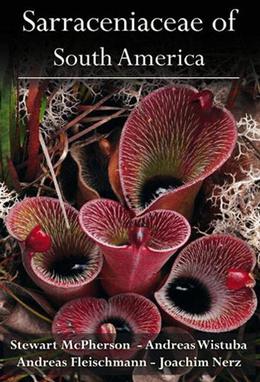
Sarraceniaceae of South America is a monograph on the pitcher plants of the genus Heliamphora by Stewart McPherson, Andreas Wistuba, Andreas Fleischmann, and Joachim Nerz. It was published in September 2011 by Redfern Natural History Productions and covered all species known at the time.

Sarracenin is an iridoid found in several plant species in the carnivorous family Sarraceniaceae. It also occurs in other non-carnivorous plants such as Strychnos spinosa (Loganiaceae) and Patrinia heterophylla (Caprifoliaceae).
